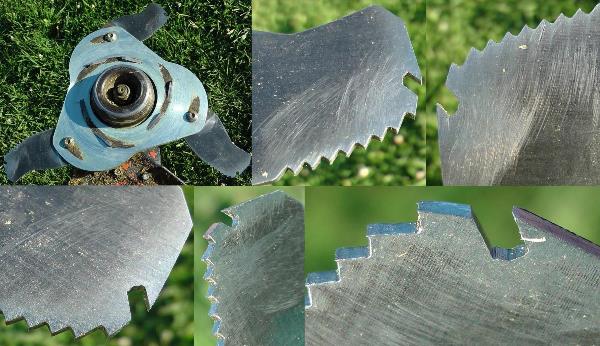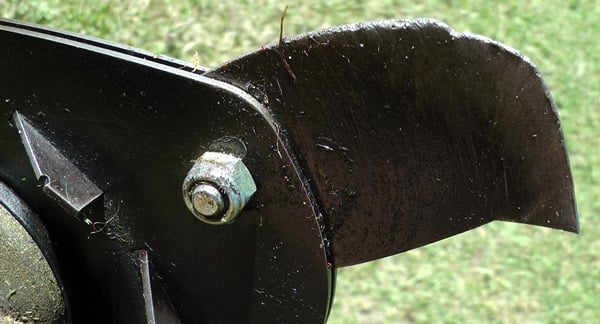This is the second most common question I get after will your blade fit my brush cutter and is also the hardest to answer as it is one of those,how long is a piece of string questions.
I have asked a commercial operator using my blades, who says that a Flail-Blade for him can last anything from half a day to two months. This probably doesn’t help you much, so lets break the BrushDestructor Blade down into is three major components.
Top & Bottom Hubs
Giving the best estimate I can for someone who owns a lifestyle block up to 10 acres, the hubs should last a lifetime.
BrushDestructor Flail-Blades
The attached and one spare replacement set of Flail-Blades should last a careful user on a 10 acre lifestyle block several years and quite possibly the life of the brush cutter. However this long life can drop very quickly if you own a very rocky property with a lot of hidden stones, If you are trimming around a lot of concrete or steel fence post, or if you live in a dry dusty area where even dust in the grass, on the branches and in the bark of trees can quickly dull the edge of the tooth requiring more frequent sharpening and is some cases if the dust is made up from hard granite rock the flail-blades (as would any other metal blade) can wear away very quickly.
How long a Flail-Blade lasts and holds its sharp edge mainly depends on your knowledge of the environment you are working in and how careful you are. In some cases when first taming a property, the wear will be very high and you may go through a few replacement Flail-Blades. But with each pass the wear will get less, provided you pick up the hidden rocks so you will not hit them the next time round.
Below are two images from a customer who was disappointed with how quickly his Flail-Blades wore away. The bank shown on the left was cleared of grass after approximately three hours of use and the photo on the right shows a lot of wear to the Flail-Blade. Working on steep banks and clearing close to the ground means that it is very easy to unintentionally hit the ground, resulting in the wear to the blade shown below.
The photos below shows before and after shots of thick rain forest, that in most places was almost too thick to walk through and was also cleared in the same three hours.
Many of the saplings varied in size from 20mm to 150mm in diameter, all were cut up into short lengths, all the small branches, leaves and vines were mulched up and left to rot away and all of this was done with a brush cutter and a BrushDestructor Blade.
Below are close ups of the blade after three hours of very hard use without any touch ups and as you can see the teeth are still very sharp.
The real enemy of any metal blade is contact with rocks, soil, dust and high velocity. I learnt early on, as a result of using a very under powered brush cutter by todays standard, was to have sharp teeth on my blades and how to maintain that sharpness for as long as possible. The two main tactics I employ is to keep as far away from the ground as possible and to use no more speed than is necessary to do the job, as having sharp teeth you do not have to run your brush cutter flat out. Unlike most metal blades which rely on sheer speed to bash their way through, sharp BrushDestructor Blades cut very efficiently and generally cut just as well at a lower speeds.
Below are photos showing the abrasion wear on the teeth after three hours, clearing very similar bush as shown above, but very close to a busy dirt road.
When it is dry as Australia often is, a lot of the road dust drifts into the bush and settles on the leaves and bark and it is this dust that can be very abrasive to all metal blades.
When you take into consideration that the tip speed of a BrushDestructor blade working hard under load is about 450km per hour, it soon becomes obvious that any dust on plants is sandblasting the sharp metal edges away. It is for this same reason that you want to try and minimize hitting rocks and burying the blade into the dirt.
The photo below, shows that BushDestructor blades are not indestructible and can easily sustain damage to Flail-Blade teeth after a high speed impact with a hidden rocks.
This rock was the tip of a submerged granite boulder which was totally un-giving and was not visible in the long grass until after hitting it. As you can see, the first flail-blade to hit sustained the most damage, with following flail-blades being less damaged as the blade was deflected away from the rock. To me this is an acceptable amount of damage as it can easily be ground out, if the steel was much harder, the whole tooth would have snapped off, which would have required a lot more grinding to create a new tooth.
Below are photos showing extreme wear to the Flail-Blades after only one tank of Petrol.
I live in a high rainfall area with about 3m of rain fall a year and it is hard to find long grassy areas with lots of hidden rocks to test for typical wear conditions found in most of Australia.
I managed to find an area of long grass with lots of hidden rocks beside a dirt road, where in the process of re-graveling and grading the road a lot of rocks was pushed into the grass area beside the road. During this tank full of clearing, I was not going out of my way to smash up the blades, but I was not being careful either. When clearing this areas beside the road, it was impossible to not hit rocks as I was trying to cut fairly close to the ground.
Even with all the leading edge serrations and the main cutting tooth totally worn away, the BrushDestructor blades still effortlessly clears grass and soft watery weeds.
So if you are trying to clear areas where there are lots of hidden rocks and you cut close to the ground. You also will get high wearing of blades as shown in the photos and will have to replace them more often. On the positive side, I didn’t have to stop once to let more line out, fix a broken line or untangle long grass that had wrapped around the gear head and I had cleared a much larger area than could have been achieved with a nylon line and most other metal blades.
To get the most from my blades, I personally touch up the teeth on my Flail-Blades each time I fill the tank of fuel, but if I know I am is a hidden stony area I will not bother sharpening the main tooth and only keep the front serrated teeth sharp. I will do a first pass to clear the area of grass and weeds without getting too close to the ground and then do a second pass much closer to the ground a couple of weeks later with a sharp blade to cut down and mulch up everything that is left. I do have a few customers who buy the 45 Pack Replacement Flail-Blades, one of them from Victoria has come back saying that he has a weekend property that needs a lot of clearing of gorse and will use a set of blades a day. At AU$16.20 for three Flail-Blades, he says for him this is very cheap for the amount of land he clears.
If you are bush clearing, you will find that it is much more productive to keep the teeth very sharp, compared to the short time it now takes to touch up the teeth with the diamond disc to keep them sharp.
AntiFouling/ImpactStop-Blades
Details to come.
Like this page, please share it with a friend












